 |
Le Fort des Têtes
Briançon, France
|
|
 |
Constructed: 1721-1733
Used by: France
Conflict in which it participated:
Napoleonic Wars
Also known as: Fort des Trois-Têtes
|
Based on a design by Vauban, the lovely Fort des Têtes is unusual in that it was larger than the town it was built to defend!
As with much of Europe, recorded history in this region begins with the doings of the Roman Empire. What is today Briançon was the Roman town of Brigantum in the first century BC. In a time when roads were scarce and air travel was reserved solely for Julius Caesar (100BC-44BC), the passes through the Alps were vital routes, and Brigantum was right there at the Montgenèvre Pass. |
 |
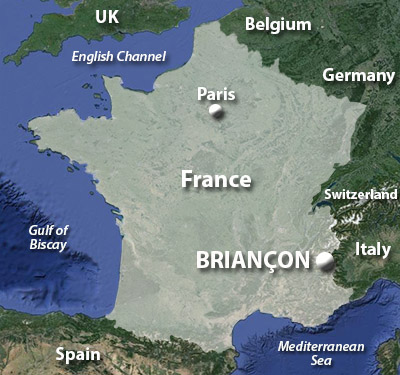 |
|
The land of Savoy, which existed from the 11th through 18th centuries, was in the Alpine region where France, Italy and Switzerland meet today: Briançon is on the French side of what was Savoy's southern border. Despite being a little kingdom, Savoy was aggressive. The Savoyards sent raiding parties into France in 1691 and 1692, as France's Alpine border wasn't properly fortified to defend against such incidents. Briançon was defended by medieval walls, but the Middle Ages had long since passed.
|
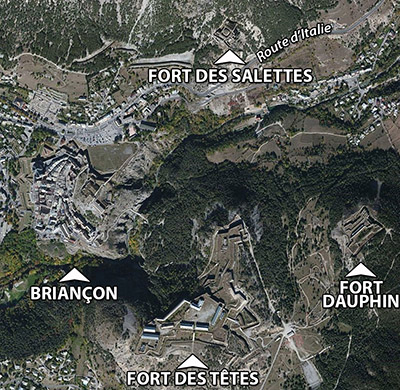 The starforts in the immediate vicinity of Briançon. |
 |
Fortunately for France, the Father of the Starfort, Sébastien Le Prestre de Vauban (1633-1707), was both alive and active during this period. Vauban was French King Louis XIV (1638-1715)'s personal fortification troubleshooter, and was sent to Briançon following the attacks from Savoy to beef up the area's defenses.
When Vauban first visited Briançon in 1692, new defenses had already been started by a local builder by the name of d'Angrogne. These had been adaptions of the town's existing medieval walls, and their crudity made Vauban's upper lip curl in a sneer of professional distaste.
Vauban designed his customary state-of-the-art defenses for Briançon, but somehow ignored the high ground all around the town, which surely would have filled with enemies and their cannon should war come to this region. Vauban left in 1692, satisfied that his fortification improvements had gotten underway.
|
|
|
When he returned in 1700, Vauban was pleased with the state of Briançon's defenses, but suddenly realized that his shiny new fotifications were pointless, as the town was completely surrounded by undefended high ground! It was at this time that he designed the starfort of our current interest, the Fort des Têtes. Têtes translates as heads. Although The Fort of Heads sounds like an awesome, if creepy, fortification built with the severed heads of one's enemies, the French didn't have enough disembodied Savoyard or British heads available at the time, and were thus forced to use more traditional building materials.
|
|
 |
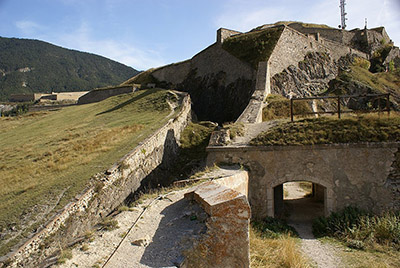 The intricate works of Briançon, where its walls lead up to the town's Citadel, which has recently sprouted its own cell phone tower. Good place for a spirited game of hide-n-seek! And a phone call. The intricate works of Briançon, where its walls lead up to the town's Citadel, which has recently sprouted its own cell phone tower. Good place for a spirited game of hide-n-seek! And a phone call. |
|
Work finally got underway on le Fort des Têtes in 1721, some six years after Vauban's death. The bridge, the Pont d'Asfeld , was completed in 1728. This bridge was a particularly impressive feat, given the rough terrain and lack of local building materials (again, not enough disembodied heads available).
|
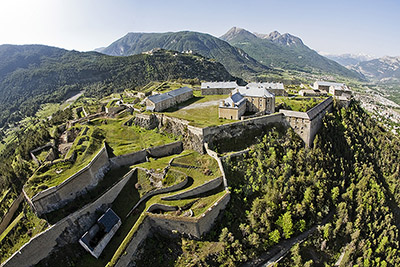
Le Fort des Têtes.
Let's see you sack Briançon now, wicked Savoyards! |
 |
The reason Briançon was of such strategic importance was the Route d'Italie. This was the one pass through this section of the Alps o'er which east/west travel was possible, and it was to the direct north of this route, and of Fort des Têtes, that little Fort des Salettes was built.
Briançon managed to avoid conflict for most of the Napoleonic Wars (1803-1815), but an Allied army finally made it through the passes in 1815. Briançon and its forts managed to withstand a three-month siege that year, and remained undefeated when the Treaty of Paris of November 20, 1815 ended the war. At which point it was defeated in that all of France was defeated. But Briançon was never defeated defeated, thank you.
|
|
|
|
|
 |
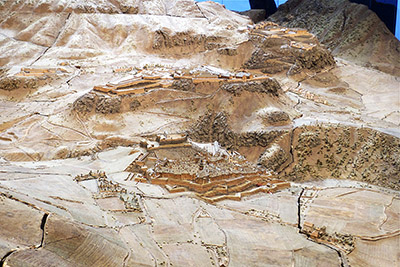
An incredible relief map of Briançon and its surrounding forts in 1733, at Paris' Musée des Plans-Relief. Le Fort des Têtes is in the center, above the fortified town. |
|
On June 20, 1940, the guns of Fort Chaberton opened fire on a number of the fortifications around Briançon, including le Fort des Têtes and Fort Infernet. Only minor damage resulted, due to the inability of the Italian gunners to hit that at which they were aiming at this relatively long distance. Though unable to immediately reply due to clouds covering Mont Chaberton, the following day four 280mm Schneider Model 1914 mortars at Fort Infernet were able to take down six of the eight Italian gun towers. A fort saves Briançon once again!
|
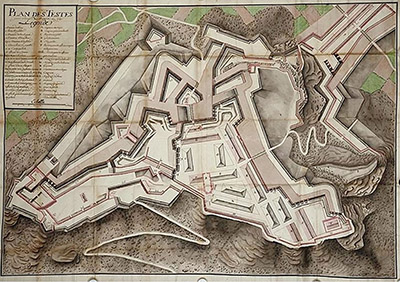
Should you wish to build your own Fort des Têtes, here is a handy plan. |
 |
Though the southeast of France was part of the "free zone" upon France's occupation by Germany in 1940, once Allied forces had landed in French North Africa in November of 1942, the Nazis went ahead and occupied all of France, which included Briançon. Our spunky little fortified town was liberated on September 7, 1944, by the 4th Regiment of Moroccan sharpshooters.
Since 1994, the French military has used Briançon and its environs as a training area, to familiarize infantry units with "a difficult natural environment." At an altitude of 4,350 feet, Briançon is France's highest city. Though probably not in the same sense that Denver is America's "highest city." |
|
|
|
Two of Briançon's other forts
|
|
|
|
|
|
 |




